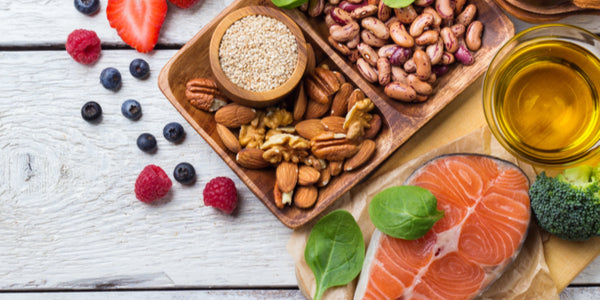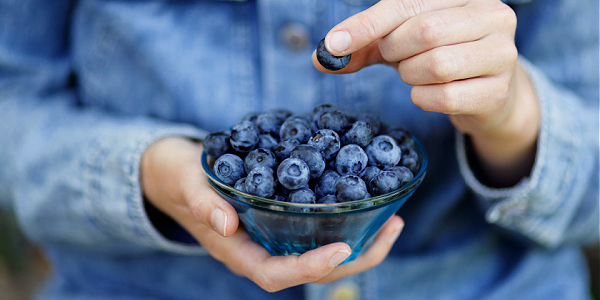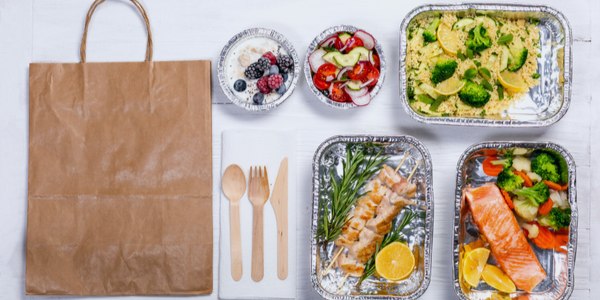
What does it take to create a heart-healthy diet plan? Find out how to DIY with these simple tips, tricks, and recipes!
How to Create Heart-Healthy Diet Plan for Weight Loss
When eating for a healthy heart, diet recommendations mostly align with with those encouraged for weight loss and simply overall health: Increasing wholesome foods and reducing the consumption of those produced with enriched and refined flours, sugars, and other additives.
Below further details the components of a heart-healthy (or cardiac) diet, along with a sample 7-day menu.
1. Load Up On Produce
Fruits and veggies are key for not only a heart-healthy diet plan, but health in general. Swap out fried vegetables, as they are likely to contain trans fats, with veggies that are high in dietary fiber such as spinach and broccoli.
The inclusion of fruit also grants heart-healthy nutrients and can help satisfy that sweet tooth, which is an extremely valuable task considering the link between high-sugar diets and cholesterol. But when going for fruit, opt for whole pieces rather than in juice form, as whole fruits offer fiber that juices lack.
Dietary fiber is a component of found in plants that cannot be absorbed or digested within the body. Along with its notorious role for bowel regularity, fiber helps manage weight, lower cholesterol, and protect from heart disease. Fiber recommendations are 38 grams per day for men and 25 grams for for women.
2. Add Whole Grains
Whole grains add fiber, B vitamins, and other valuable nutrients shown to improve both blood pressure and cholesterol levels.
Whole grains should comprise at least 50 percent of total grain consumption and are sourced from oats, barley, wheat, and the products they produce such as wheat breads and pastas.
3. Choose Fats Wisely
Unlike popular belief, eating for the heart and overall heart does not dismiss dietary fat. In fact, the body needs fat to maintain cell structure and integrity, insulate vital organs, assist in the absorption of fat-soluble vitamins, and other valuable physiological processes.
The concern of fat mostly relates to the type of fat, with high intakes of trans and saturated fats can cause weight gain and increase the risk of chronic health conditions, including heart disease.
Swap out trans and saturated fats with healthier fat sources, including monounsaturated (MUFAs), polyunsaturated (PUFAs), and omega-3 fatty acids. Healthy fat sources include fatty fish, nuts and seeds, avocados, and olive and canola oils. fight against heart disease, including reducing the risk of a heart attack, stroke, and sudden cardiac death.
Also go for leaner cuts of meats, including skinless chicken, turkey, and sirloin. Their precedence in the diet has not only shown to support heart health, but can even facilitate weight loss
4. Season for the Heart
Whereas sodium is a valuable mineral and electrolyte for regulating fluid balance within the body, too much of it can increase blood pressure. And with heart disease being the number one killer in the U.S., there is a need to go easy on the salt.
So to moderate sodium intake, go easy on the salt shake, limit processed and packaged foods, and opt for more wholesome, heart-healthy foods described above. Also simultaneously reduce salt intake and enrich flavor by spicing it up in the kitchen with fresh or dried herbs and seasonings.
The general recommendation of sodium intake is 2,400 milligrams (mg) per day or 1,400 mg if directed by a medical provider, commonly related to high blood pressure and congestive heart failure.
A Sample 7-Day, Heart-Healthy Diet Plan
Below depicts meal and snack selections generous enough to cover a full week.
But despite the nutritionally adequacy of the meals and snacks, it is likewise important to consult with your primary care provider or a Registered Dietitian to help you identify nutritional needs customized to you.
Day 1
Breakfast:
• 1 serving of oatmeal (½ cup dry oats) prepared with one cup water or skim milk, 1 sliced banana, 1 tablespoon of nut butter, and a dash of cinnamon
Lunch:
• 1 roast beef roll-up: Spread mustard on a whole-wheat wrap, add four slices of roast beef, four thin slices of tomatoes, ½ cup of lettuce, and ½ cup of red or green peppers. Tightly roll then cut into four equal sections.
• 1 medium banana
Dinner:
• 1 serving of this Greek stuffed peppers recipe
• 1 cup green beans sautéed in a ½ tablespoon of olive oil
Daily Tip:
Make oats overnight for a quick, convenient breakfast.
Day 2
Breakfast:
• 1 veggie omelet, also feeling free to adjust veggies to liking
• 1 cup of blueberries or grapes
Lunch:
• 1 serving of tuna salad: Mix a 5-ounce can of wild albacore tuna with a small avocado, diced carrots and celery, a tablespoon of lemon juice, and salt and pepper to taste. Consume as is, top onto 2 slices of whole grain bread, or dip with sliced bell peppers, cucumbers slices, or carrot sticks
• 1 medium apple
Dinner:
• 1 side salad with 1 to cups of raw spinach leaves, tomatoes, and cucumber slices topped with Greek yogurt ranch dressing
• 1 serving eggplant pizza
Daily Tip:
Get the whole family involved for a pizza party! Set out random toppings and allow them to dress their own pizza.
Day 3
Breakfast:
1 yogurt-filled cantaloupe: Start by horizontally slice a cantaloupe in half. Spoon out the pulp and seeds, scoop Greek yogurt into the created "bowl" inside the hollowed cantaloupe, and sprinkle with nuts or seeds for an extra crunch. Enjoy straight from the cantaloupe – no dishes required!
Lunch:
• 1 turkey sandwich: 2 slices of whole grain bread, 4 ounces of sliced turkey, assorted veggies, like mixed greens and sliced tomatoes. Smear the bread with 1 tablespoon mustard or olive oil-based mayo.
• ½ cup cottage cheese
• ½ cup pineapple chunks
Dinner:
• 1 serving mango and avocado salad
• 2 fish tacos with broccoli slaw
Daily Tip:
Rather than purchasing packaged lunch meat, get it straight from the butcher in the deli to lower sodium content. Bread is also a common source of sodium, so be on the lookout for low-sodium brands, or at least supplying 140 mg sodium or less per serving.
Day 4
Breakfast:
• 1 yogurt parfait: 1 cup plain Greek yogurt, 1 cup fresh blueberries, 1 tablespoon chopped nuts, 1 tablespoon honey, dash of cinnamon
Lunch:
• 1 serving of chopped chicken salad: Top three ounces of chopped chicken, two tablespoons of crumbled low-fat bleu cheese, ½ cup of chopped cucumbers, 1 tablespoon of chopped pecans and dried cranberries on 2 cups of chopped salad greens tossed with 2 tablespoons of vinaigrette
• 1 orange
Dinner:
• 4-ounces roasted turkey breast
• ½ cup wild rice and mushroom pilaf
• 1 cup steamed broccoli
Daily Tip:
After dinner, walk the family dog, bike around the neighborhood, or other physical activity to elevate heart rate.
Day 5
Breakfast:
• 1 serving chocolate banana protein smoothie: Simply combine 1 scoop of chocolate protein powder (or enough for 25 to 30 grams of protein), 1 small banana (frozen), ½ cup milk of choice, 1 teaspoon dark chocolate, and ½ cup into a blender and mix until fully combined
Lunch:
• 1 spicy refried black bean burrito
• 1 cup cubed watermelon
Dinner:
• ½ cup grilled asparagus
• ¾ cup grilled potatoes and peppers
• 1 jalapeno turkey burger
Daily Tip:
Add 1 to 2 tablespoons of chia or flax seeds to the smoothie for added heart-healthy fiber and omega-3s.
Day 6
Breakfast:
• 1 serving high-protein pancakes, topped with peanut butter, berries, and other favorites
Lunch:
• 1 serving creamy carrot and sweet potato soup
• 2 cups mixed greens with 1 cup of preferred chopped veggies (including broccoli, carrot, and cucumber), 1 tablespoon balsamic vinegar
Dinner:
• ½ cup baked coconut plantains
• ½ cup black beans
• 1 serving pulled pulled pork with salsa verde
Daily Tip:
Savor the leftovers of the carrot and sweet potato soup by freezing and reheating when ready to enjoy again.
Day 7:
Breakfast:
• 1 avocado egg: Slice avocado in half and take out the large pit. Crack an egg into the created dip and bake until the egg whites are cooked and the yolk is at a desired firmness. Sprinkle atop with green onions, diced tomatoes, and a dollop of plain Greek yogurt. Drizzle with hot sauce for a little added spice!
• 1 navel orange
Lunch:
• 3-ounces grilled chicken breast
• 1 cup of quinoa tabbouleh
Dinner:
• 1 serving Thai salmon topped onto ½ cup brown rice
• 1 cup steamed broccoli
Daily Tip:
Add flavor to the brown rice with minced garlic and other favorite herbs and spices. Also bulk up the rice with various veggies for added fiber and micronutrients, along with making it in large batches for nutritious leftovers to start off a new week.
A.M. and P.M. Snack Options
If hunger calls, choose one of the following options for A.M. and P.M. snacks each day:
• 1 ounce of mixed nuts, including almonds, cashews, and walnuts
• ½ cup cottage cheese with 1 cup fresh pineapple or peach slices
• 1 medium apple with 1 tablespoon of nut butter
• 1 cheese stick with ½ cup grapes
• 3 cups of plain, air-popped popcorn
• 1 ounce of beef jerky
• 1 large hardboiled egg
• 8-ounces of fat-free chocolate milk
• 1 ounce of pumpkin seeds
• 6-ounces of non-fat, plain Greek yogurt with a ½ cup of berries
• 1 cup carrot sticks dipped into 2 tablespoons of hummus
Beverages
When it comes to beverages, women and men should aim for 2,700 milliliters (ml) and 3,700 ml daily, respectively. Most fluid needs should come from water, though unsweetened coffee, tea, milk, 100 percent fruit juices, and water-rich fruits and veggies can offer hydration.
Ultimately, limit the intake of soft drinks, energy drinks, and sugary and calorie drinks that provide no nutritional value.
A Heart-Healthy Diet Made Easy
Desiring a heart-healthy diet plan delivered straight to your door? Look no further than a weight loss meal delivery service.
Seasoned and award-winning chefs have prepared a variety of meals that fall at or below the American Heart Association's (AHA) recommendations for calories, sodium, total fat and saturated fat. All of these meals contain less than 600 mg of sodium and less than 3.5 grams of saturated fat to support heart health.
Each meal also contains 1,100 to 1,400 calories daily with 40 to 50 percent of total caloric intake from lean, adequate protein, 20 to 25 percent of calories from healthy fats, and 30 to 35 percent from complex carbohydrates. The combination of macronutrients is scientifically-proven to help jumpstart and sustain healthy weight loss!
Ordering heart-healthy meals has never been so easy: Simply select your heart-healthy program, choose a plan that best fits your schedule, and start creating your customized menu!








